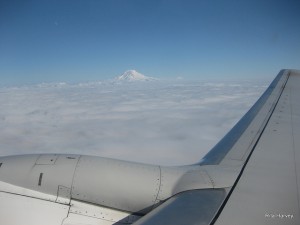
A nice view of Mount Rainier.
Not that long ago I wrote a blog talking about Koito falsifying the safety of their seats and about three Eva Air Boeing 777’s sitting at Paine Field with no seats. Well, the story now gets better (or I guess worse).
Mary Kirby on FlightGlobal.com highlights the new issues facing the Koito seats. Due to Koito’s lack of following proper procedures 150,000 seats flown all over the world could have unknown safety issues and now the Federal Aviation Administration (FAA) and the European Aviation Safety Agency (EASA) have proposed airworthiness directives (AD) for the seats. The EASA proposal is a bit more strict than the FAA.
“The Japanese airworthiness authority (JCAB) has informed EASA that a review of the safety of passenger seats manufactured by Koito industries has disclosed discrepancies which include falsification of static, dynamic and flammability testing, as well as uncontrolled changes to production data (material and dimensional),” says EASA in its proposed AD.
“In addition JCAB confirmed that Koito records, showing evidence of falsification, could not be deemed complete. Examples include: fictitious dynamic test pulse plots inserted into test reports following failure to meet required certification requirements; flammability test coupons not representative of production parts, for instance by use of alternative adhesive not specified on the approved drawing; and fictitious deformation values entered in test reports when values exceeded the maximum allowed.”
Because of all the issues, the EASA has asked airlines to remove all Koito seats with-in the next two years. However, if additional testing shows the seats are safe, this could be changed to ten years. The FAA’s proposal puts it onto the airlines to test the seat’s safety. If airlines determine the seats are unsafe, they must be removed.
“Because this proposed AD will not require full compliance with every applicable regulation, seats on which the requirements of this proposed AD are completed successfully and are permitted to remain in service are limited in how they can be used. That is, unless they are shown to fully comply with the regulatory requirements, this proposed AD would restrict the installation of such seats and would require specific marking. These seats can be used as a direct spare for the same part number seat. However, any other use of such seats would be considered a new installation approval and would be required to comply with all regulations. Thus, seats not meeting all regulations could not be installed except as noted above, and if removed from an approved arrangement, would have to be destroyed or rendered unusable in some other manner acceptable to the FAA,” says the agency in its proposed AD.
The FAA estimated that its directive would affect 40,365 seats on 278 airplanes in the US with a total estimated cost of $875,000. However, I assume that the cost would be much higher than that.
Flight Global asked the FAA if they are concerned that unfavorable comparisons will be made about the their AD versus the EASA’s. An FAA spokesman explained, “Clearly the FAA doesn’t operate in a vacuum, but that said what we have to do is look at the safety impact and the safety issue and the proposed solution based on our environment, not the environment that exists in Europe.”
Most of the Koito seats flying in the US are on Continental Airlines aircraft. It looks like they anticipated this direction and have already started testing. “We’ve been working closely with the FAA over the past year in anticipation of the proposed rulemaking and have completed initial testing on the majority of our aircraft,” Julie King with Continental Public Relations explained to me via an email.
I started looking into this story because of the three Eva Air Boeing 777’s sitting at Paine Field, so I wanted to check in with them to see their status. They are still sticking with the, “no comment,” stance, which again, is not surprising.
So, what does this mean to you? Not too much, unless it turns out these seats are unsafe you end up sitting in one during an incident. However, as explained earlier, the chances of being in any airline seat during an accident, is very rare, being in a Koito seat is even less likely.
Comments are closed here.
I would like know when this FAA data was issued. I have not heard this Koito aircraft seats issue since Feb。